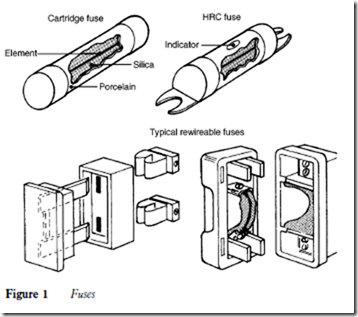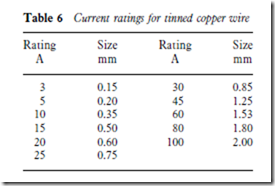Every electrical installation must be protected from current overload. This is achieved by locating a protective device at the commencement of each circuit in the form of a fuse or circuit breaker. Their function is to protect the circuit conductors (cables) and not the appliance or user.
Fuses
Three types of fuse are used (Figure 100); the rewireable or semi-enclosed fuse; the cartridge fuse or fuse link; and the high rupturing capacity (HRC) fuse.
Rewireable fuse
This comprises a fuse holder, an element and a fuse carrier. The holder and carrier can be made of porcelain or bakelite. The fuse holder is colour coded as follows:
45 A green
30 A red
20 A yellow
15 A blue
5 A white
This type of fuse is popular for domestic appliances and small commercial units because of cheapness and ease of replacement. It is not recommended for commercial refrigeration duty because of these disadvantages:
1 The fuse carrier can be loaded with the wrong size fuse wire.
2 The fuse element tends to weaken after long usage owing to oxidation of the wire by heating in air. This causes it to fail under normal conditions,
i.e. normal starting current surges are sensed by the fuse as an overload.
3 The fuse holder and carrier can be damaged as a result of arcing in the event of an overload.
Cartridge fuse
This consists of a porcelain tube with metal end caps to which the fuse element is attached. The tube is filled with silica.
These fuses may be used in plug tops with 13A socket outlets and in distribution boards. They are recommended for refrigeration duty. They have the advantages over the rewireable types of not deteriorating, of being more accu- rate in breaking at the rated value, and of not being subject to arcing.
HRC fuses
This is a sophisticated version of the cartridge fuse. It is normally used for the protection of motor circuits in commercial and industrial installations. It consists of a porcelain body filled with silica and with a silver element; the body terminates in lug-type end caps.
These fuses are fast acting, and can discriminate between a starting surge and an overload. An indicating element shows when the fuse is ruptured.
Rating
The selection of fuse ratings depends on the full load current, the locked rotor current and the cable size. The current ratings for tinned copper wire are shown in Table 6.
Fusing factor
Different types of fuse provide different levels of protection. Rewireable fuses are slower to operate and are less accurate than cartridge types.
To classify the protection devices it is important to know the fusing perfor- mance. This is achieved by the use of a fusing factor:
fusing current fusing factor D current rating
Here the fusing current is the minimum current causing the fuse to rupture, and the current rating is the maximum current which the fuse can sustain without rupturing. For example:
1 A 5 A fuse ruptures only when 9 A flows; it has a fusing factor of 9/5 or 1.8.
2 The current rating of a cartridge fuse is 30 A and the fusing factor is 1.75; the fuse will rupture at 30 ð 1.75 D 52.5 A.
3 The current rating of an HRC fuse is 20 A and the fusing factor is 1.25; the fuse will rupture at 20 ð 1.25 D 25 A.
It must therefore be realized that a fuse is rated at the amount of current it can carry, and not the amount at which it will rupture. Rewireable fuses have fusing factors of approximately 1.8; cartridge fuses of between 1.25 and 1.75; HRC fuses of up to 1.25 maximum; and motor cartridge fuses of 1.75.
Related posts:
Incoming search terms:
- rewirable fuse
- rewireable fuse
- fusing factor of hrc fuse
- rewirable fuse diagram
- rewireable fuse function
- semi enclosed fuse
- rewireable fuse diagram
- rewirable fuses
- cartridge fuse diagram
- rewirable fuse advantages and disadvantages
- The fusing factor of HRC fuse is
- diagram of rewireable fuse
- semi-enclosed fuse
- difference between hrc fuse and rewirable fuse
- rewireble fuse
- operation of block diagram of a rewirerable fuse
- diagram of rewirable fuse
- rewirable type fuse
- advantages of semi-closed fuses
- rewireable fuse definition
- what is rewirable fuse
- what is the fusing factor of hrc fuse
- semi enclosed fuse symbol
- standard rewirable fuse link\
- labelled of a fuse
- why HRC is preferred over re wire able fuses
- what is rewireable fuse
- The fusing
- Wireable fuse
- fusing factor of rewirable fuse
- fusing factor of HRC fuse is
- what is a rewireable fuse
- semi enclosed rewirable fuse
- difference between hrc and rewirable fuse
- draw semi_enclosed fuse and label the parts
- advantage of cartride fuse over semi enclose fuse
- advantage and disadvantage of rewirable fuse
- fusing factor
- SEMI ENCLOSED REWIREABLE FUSE BREAKING CAPACITY IS LOW MADE UP TO CURRENT RATING OF
- parts of a rewirable fuse
- rewireable
- rewirable fuse application
- why HRC is preferred over rewireable fuses
- Advantage of rewirable fuse
- advantage of rewireable fuse over miniature circuit breaker
- HRC fuse and rewirable fuse
- picture of rewireable fuse
- Re-wire able fuse application
- Application for rewirable fuse
- non rewirable fuse

